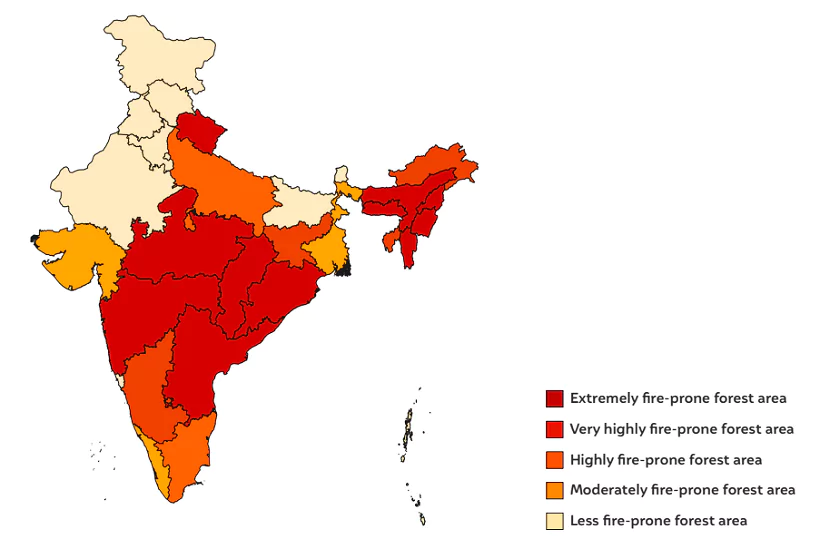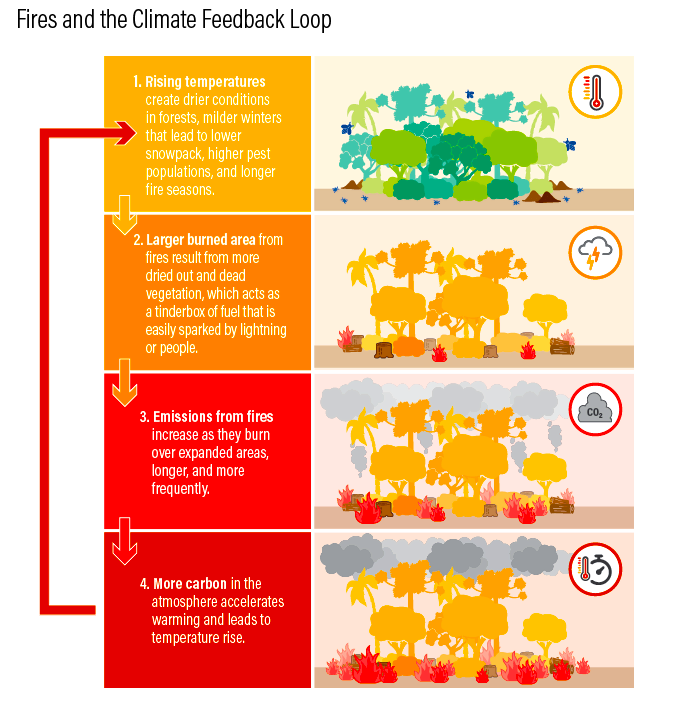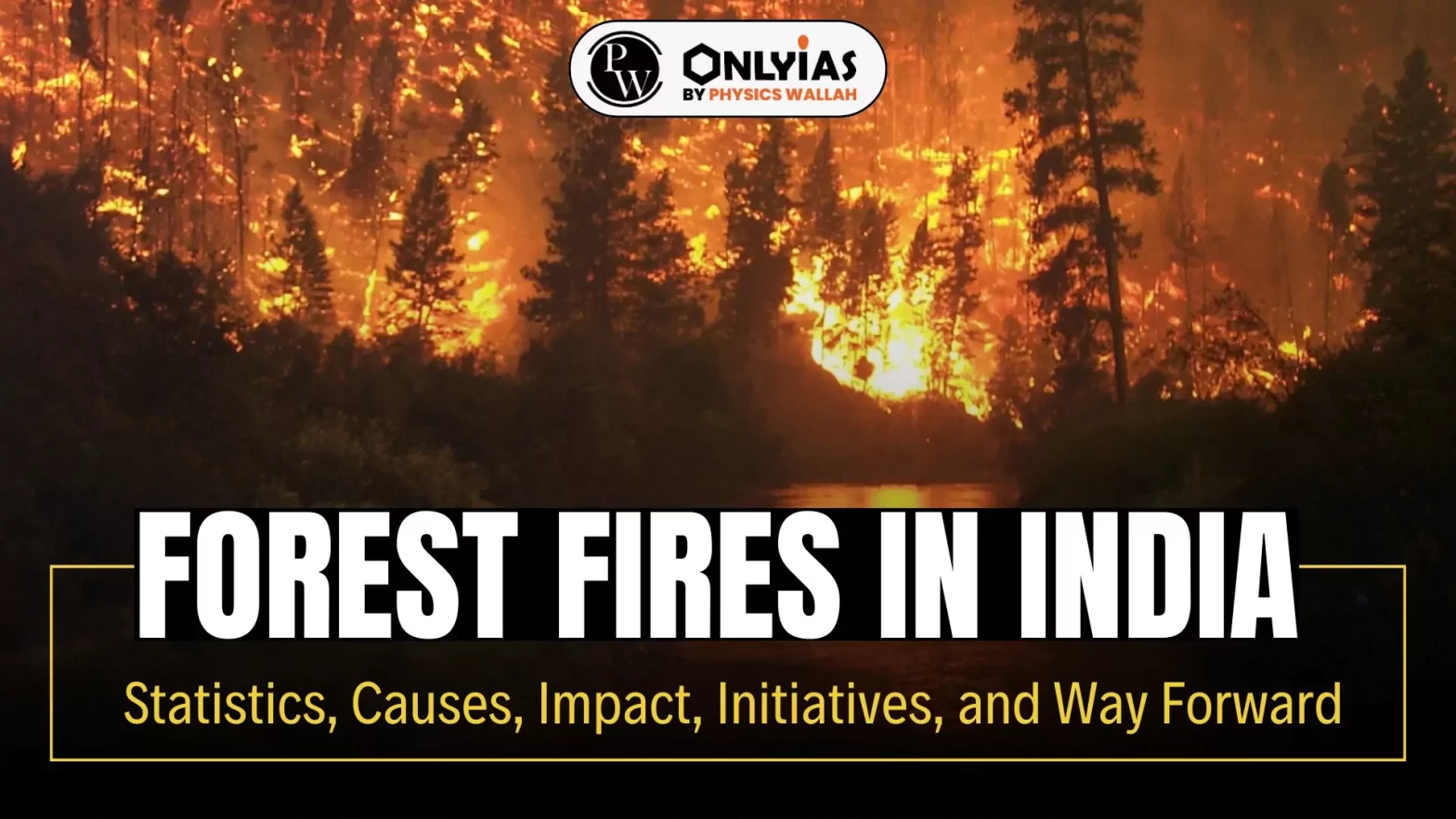Context
This Article is based on the news “Heat, aridity, clear skies: why forests are already ablaze in the Nilgiris” which was published in the Indian Express. Forest fires have been raging in the Coonoor forest range in the Nilgiris in Tamil Nadu for almost a week.
Nilgiris Forest Fire: Key Highlights
- Bambi Bucket Operations: The Indian Air Force deployed a Mi-17 V5 helicopter to conduct multiple “Bambi Bucket operations” that dumped some 16,000 litres of water on the fires.
- The Bambi Bucket, also called a helicopter bucket or a helibucket, is a specialised container that is suspended by cable under a chopper, and which can be filled by lowering into a river or pond before being flown above a fire and discharged aerially by opening a valve at the bottom of the bucket.
What is Forest Fire?
- Wildfire, also called forest, bush or vegetation fire, can be described as any uncontrolled and non-prescribed combustion or burning of plants in a natural setting such as a forest, grassland, brushland or tundra.
Forest Fires in India: Statistics
- Forest Fires in India: According to the biennial India State of Forest Report (ISFR) 2019 published by the Forest Survey of India (FSI), more than 36% of India’s forest cover was prone to frequent fires.
 About 4% of the forest cover was ‘extremely prone’ to fire, and another 6% was ‘very highly’ fire prone.
About 4% of the forest cover was ‘extremely prone’ to fire, and another 6% was ‘very highly’ fire prone.
- Vulnerable States: The eleven main states with frequent occurrence of forest fires in recent times are:
- Andhra Pradesh, Assam, Chhattisgarh, Himachal Pradesh, Mizoram, Madhya Pradesh, Maharashtra, Odisha, Telengana Uttar Pradesh and Uttarakhand.
- Forest Fire Vulnerability Across Ecosystems: According to the FSI, severe fires break out in dry deciduous forests, while evergreen, semi-evergreen, and montane temperate forests are comparatively less prone to fires.
- The forests of Northeast India, Odisha, Maharashtra, Jharkhand, Chhattisgarh, and Uttarakhand are the most vulnerable to fires during the November to June period.
- Triggering Factors:
- Human activities trigger 95% of forest fires in India, such as burning agricultural practices, deforestation, firewood burning etc.
- Drought and higher temperatures further aggravate the risk of forest fire.
- Forest Fire Season in India: November to June is considered to be forest fire season in India especially from February onward as summer approaches.
- April-May are usually the worst fire months across the country.
- Forest Fire Situation in 2024: During March 2024, the highest number of forest fires were reported from Mizoram (3,738), Manipur (1,702), Assam (1,652), Meghalaya (1,252), and Maharashtra (1,215), as per FSI data.
Causes of Forest Fires in India
Causes of Forest Fires in India are as follows;
-
Natural Causes:
- Lightning: Lightning-caused forest fires are caused by thunderstorms where the lightning strikes combustible materials on the ground under conditions that support combustion.
- Volcanic Eruption: Hot magma from the earth’s crust is expelled as lava during a volcanic eruption, causing it to flow down mountainsides and spread out over the forest floor, starting fires.
- High Temperatures: Hot and dry temperatures and high tree density help the spread of forest fires.
-
Anthropogenic Causes:
-
- Fire is caused when a source of fire like naked flame, cigarette or bidi, electric spark or any source of ignition comes into contact with inflammable material.
What Are Reasons For Forest Fires in India This Year?
- Rise in Mean Temperatures: Over the past two months, the recorded maximum, minimum, and mean temperatures have remained above-normal over the southern states, which has helped build the heat load over the region well before the onset of the summer season.
- Maximum temperatures here touched 40 degrees Celsius which is unusual for mid March.
- Drymass Availability: As a result, there has been an early availability of dry biomass in these forests since the winter season itself.
- Hottest Month of South India: This February was South India’s hottest since 1901, and January was the fifth warmest in more than a century.
- Prevalence of Excess Heat Factor (EHF): The IMD has warned of the prevalence of EHF to be significantly higher than normal over western Andhra Pradesh and neighbouring Karnataka.
- EHF predicts the chances of a heatwave over a region.
- Prevalence of Aridity: In the absence of rain and prevailing high temperatures, the IMD has classified almost all districts of southern India under ‘mild’ aridity.
Classification of Forest Fires
- Surface Fire: A forest fire may burn primarily as a surface fire advancing across the forest floor as the flames spread through the surface litter and vegetation.
- Underground Fire: The fires of low intensity, consuming the organic matter beneath and the surface litter of forest floor are sub-grouped as underground fire.
- These fires usually spread entirely underground and burn for some meters below the surface.
- Ground Fire: These fires are fires in the subsurface organic fuels, such as duff layers under forest stands, Arctic tundra or taiga, and organic soils of swamps or bogs.
- This fire burns root and other material on or beneath the surface i.e. burns the herbaceous growth on forest floor together with the layer of organic matter in various stages of decay.
- They are more damaging than surface fires, as they can destroy vegetation completely.
- Crown Fire: A crown fire is one in which the crown of trees and shrubs burn, often sustained by a surface fire.
- On hill slopes, if the fire starts downhill, it spreads up fast as heated air adjacent to a slope tends to flow up the slope spreading flames along with it. If the fire starts uphill, there is less likelihood of it spreading downwards.
Impact of Forest Fires

- Biodiversity Loss: Forest fires have adverse effects on the forest cover, tree growth, vegetation, and the overall flora and fauna.
- Fires render several hectares of forest useless and leave behind ash, making it unfit for any vegetation growth.
- Soil Erosion: Forest fires leave the soils bare to the action of natural elements i.e. sun, wind and rain, leading to soil erosion and loss of top fertile soil.
- Soil Fertility: It leads to destruction of soil organic matter and affects the soil structure adversely.
- Nitrogen reserves of the soil are depleted.
- Fire also destroys humus and soil micro-flora, which in turn affects the forest growth.
- In North-Eastern India, the shortening of fire-associated jhum cycles has also had a detrimental effect on soil fertility.
- Shorter jhum cycles reduce fallow biomass available for burning and gives soil fertility less time to recover, resulting in lower economic yields and efficiency.
- Jhum Cultivation is a traditional agricultural practice whereby land is cleared by burning the vegetation, is cultivated for several years, and then is abandoned in favour of another site when the productivity of the soil declines.
- Growth in IAS: Some invasive alien species (IAS) in India’s forests are fire-assisted.
- Forest fragmentation, coupled with fires-have resulted in degradation of ecosystems, making them more vulnerable to invasion by alien species. Ex- Lantana camara fuels further fires.
- Damage to Wild animals: Forest fire results in enormous loss to wildlife and birds. It causes loss of habitat for the wild fauna making them susceptible to death due to poaching, adverse weather conditions or killing by predator species.
- Air Pollution: Forest fires emit heat-trapping gases such as N₂O and other aerosols that influence the regional and global climate.
- Forest clearing and persistent changes in vegetation composition and structure after a fire may result in net emissions.
- Climate Change: Forest fires contribute to climate change by releasing carbon stored in trees, undergrowth, litter, and soils into the atmosphere.
Initiatives Taken to Prevent Forest Fires in India
- National Disaster Management Plan (NDMP) 2019: Under the revised NDMP 2019, Forest Fire has been included and addressed as a hazard, with specific time bound action plans, and clear roles & responsibilities of Central, State agencies and key stakeholders.
- Forest Fire Alert System: Since 2004, the FSI developed the Forest Fire Alert System to monitor forest fires in real time.
- In its advanced version launched in January 2019, the system now uses satellite information gathered from NASA and ISRO.
- Fire Weather Index based Forest Fire Danger Rating System (FFDRS): It Identifies vulnerable areas on the ground for
- Risk reduction and mitigation
- Identification of highly fire prone areas
- Resource allocation and mobilization
- Van Agni Geo-portal: It serves as a single point source for the information related to forest fires in India.
- National Action Plan on Forest Fires (NAPFF): It was launched in 2018 by MoEF&CC to minimize forest fires by informing, enabling and empowering forest fringe communities and incentivizing them to work with the State Forest Departments.
Measures Suggested by NAPFF
- Fire Risk Zonation and mapping
- Risk factors
- Use of fire risk zones in forest planning
- Preventing forest fires:
- Effective communication strategy
- Empowering Communities to deliver on their responsibilities
- Capacity building of communities
- Increasing the resilience of forests to fires
- Moisture and water conservation
- Forest floor biomass management
- Weed Management
- Forest Fire Preparedness
- Forest fire detection and alert
- Digitize the location of critical resources and assets
- Forest Fire Lines
- Control Burning
- Fire Suppression
- Training for field staff, fire watchers, and community firefighters
- Equipping the firefighters
- Development of adequate infrastructure for fire suppression
- Arrangements for adequate manpower
- Post Fire management
- Assessment of loss due to forest fires
- Proper investigation of the causes
- Restoration of fire affected areas
- Coordination with Other Agencies
- Centre of Excellence for Forest Fires
|
Institutional Set up for Forest Fire Management in India
- At present, the Forest Protection Division, headed by Inspector General (IG) level officer looks after the forest fire management work at National level with the cooperation of National Disaster Management Authority (NDMA), Disaster Management (NDM) Division of Government of India, National Institute of Disaster Management (NIDM), International organisations, Forest Survey of India (FSI), Forest Research Institute (FRI) and other regional offices of MoEF in the country.
Best Practices:
- Australia’s Bushfire Safety System: It encourages people to use an exclusive App in Victoria region, which provides timely information about the fire risks and helps the stakeholders in decision making.
- Indonesia’s Fire Free Village Program: It inspires local communities, NGOs and other stakeholders to address causes of fires.
|
Way Forward
- Forest Fire line: It includes preventing fire through removal of forest litter all along the forest boundary known as “Forest Fire Line” .
- This line prevents fire breaking into the forest from one compartment to another. The collected litter was burnt in isolation.
- Creating Firebreaks: Generally, the fire spreads only if there is a continuous supply of fuel (Dry vegetation) along its path.
- The best way to control a forest fire is therefore, to prevent it from spreading, which can be done by creating firebreaks in the shape of small clearings of ditches in the forests.
- National Forest Fire Knowledge Network: It must be established to cover all dimensions of forest fire in the country.
- Such a network must be tuned to the felt need of all stakeholders, including forest fire managers, policy makers and planners, decision makers, community etc.
- Capacity Building: Enhance the capacity of forest personnel and institutions for timely detection of possible fire events and for fighting forest fires.
- There is an urgent need for enhancing the capacity of forest guards at the best levels in terms of training, workforce, equipment etc. to enable them to effectively deal with forest fires.
- Separate Division for Forest Fire Management: It is required that for effective dealing, a separate division be established for forest fire management, which could deal exclusively with the forest fire issue.
- Promote Forest Fire Research and Technology Innovations: The research institutes are needed to do research in developing appropriate techniques in getting prior information about forest fire, detecting it, and suitable mechanism to suppress it.
- Strengthening Collaboration: Necessary collaboration is required with organisations involved in generating early warning about forest fire.
- Meteorological Departments and other national and international sources providing weather related information may be collaborated to get prior information about the temperature and rainfall situation which are the main deciding factors for forest fires.
Also Read: Amendment To The Forest Conservation Act 2023
| Prelims PYQ (2021):
At the national level, which ministry is the nodal agency to ensure effective implementation of the Scheduled Tribes and Other Traditional Forest Dwellers (Recognition of Forest Rights) Act, 2006?
(a) Ministry of Environment, Forest and Climate Change
(b) Ministry of Panchayati Raj
(c) Ministry of Rural Development
(d) Ministry of Tribal Affairs
Ans: (d) |
![]() 19 Mar 2024
19 Mar 2024

 About 4% of the forest cover was ‘extremely prone’ to fire, and another 6% was ‘very highly’ fire prone.
About 4% of the forest cover was ‘extremely prone’ to fire, and another 6% was ‘very highly’ fire prone.